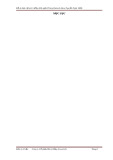
BioMed Central
Page 1 of 5
(page number not for citation purposes)
Virology Journal
Open Access
Research
Recombinant Tula hantavirus shows reduced fitness but is able to
survive in the presence of a parental virus: analysis of consecutive
passages in a cell culture
Angelina Plyusnina and Alexander Plyusnin*
Address: Haartman Institute, Department of Virology, University of Helsinki POB 21, FIN-00014, Helsinki, Finland
Email: Angelina Plyusnina - anguelina.pljusnina@helsinki.fi; Alexander Plyusnin* - alexander.plyusnin@helsinki.fi
* Corresponding author
Abstract
Tula hantavirus carrying recombinant S RNA segment (recTULV) grew in a cell culture to the same
titers as the original cell adapted variant but presented no real match to the parental virus. Our
data showed that the lower competitiveness of recTULV could not be increased by pre-passaging
in the cell culture. Nevertheless, the recombinant virus was able to survive in the presence of the
parental virus during five consecutive passages. The observed survival time seems to be sufficient
for transmission of newly formed recombinant hantaviruses in nature.
Background
Recombination in RNA viruses serves two main purposes:
(i) it generates and spreads advantageous genetic combi-
nations; and (ii) it counters the deleterious effect of muta-
tions that, due to the low fidelity of viral RNA
polymerases and lack of proofreading, occur with high
frequency [1]. The purging function is, naturally, attrib-
uted to the homologous recombination (HRec), i.e.
recombination between homologous parental molecules
through crossover at homologous sites. HRec was first
described for the positive-sense RNA viruses [2,3] and
subsequent studies lead to the widely accepted copy-
choice model [4]. HRec was later shown to occur in rota-
viruses thus adding double-stranded RNA viruses to the
list of viruses capable of recombination [5]. Negative-
sense RNA viruses that occupy the largest domain in the
virus kingdom until recently were known to undergo non-
homologous recombination only, forming either defec-
tive genomes, like polymerase "mosaics" of influenza A
virus DI-particles [6] and "copy-backs" of parainfluenza
virus [7] or hybrids between viral and cellular genes [8] or
between different viral genes [9]. The first evidence for
HRec in a negative-sense RNA virus has been obtained on
hantaviruses [10,11].
Hantaviruses (genus Hantavirus, family Bunyaviridae) have
a tripartite genome comprising the L segment encoding
the RNA-polymerase, the M segment encoding two exter-
nal glycoproteins, and the S segment encoding the nucle-
ocapsid (N) protein [12]. Hantaviruses are maintained in
nature in persistently infected rodents, each hantavirus
type being predominantly associated with a distinct
rodent host species [13]. When transmitted to humans,
some hantaviruses cause hemorrhagic fever with renal
syndrome or hantavirus pulmonary syndrome, whereas
other hantaviruses are apathogenic [14,15]. Persistent
infection in natural hosts allows for the simultaneous
presence of more than one genetically distinct hantavirus
variant in the same rodent. This may result in hantavirus
genome reassortment [16,17] or recombination, as pro-
posed in the above-mentioned study of Sibold et al [10]
who showed a mosaic-like structure of the S RNA segment
Published: 22 February 2005
Virology Journal 2005, 2:12 doi:10.1186/1743-422X-2-12
Received: 01 February 2005
Accepted: 22 February 2005
This article is available from: http://www.virologyj.com/content/2/1/12
© 2005 Plyusnina and Plyusnin; licensee BioMed Central Ltd.
This is an Open Access article distributed under the terms of the Creative Commons Attribution License (http://creativecommons.org/licenses/by/2.0),
which permits unrestricted use, distribution, and reproduction in any medium, provided the original work is properly cited.

Virology Journal 2005, 2:12 http://www.virologyj.com/content/2/1/12
Page 2 of 5
(page number not for citation purposes)
and the N protein of Tula hantavirus (TULV). Most
recently, we have shown transfection-mediated rescue of
TULV with recombinant S segment, in which nt 1–332
originate from the cell culture isolate Moravia/Ma5302V/
94 (or TULV02, for short) [18], nt 369–1853 originate
from the strain Tula/Ma23/87 [19], and nt 333–368, that
are identical in both variants, can be of either origin. Both
M and L segments of the recombinant virus (recTULV)
originate from TULV02 [11]. RecTULV was functionally
competent but less competitive than TULV02. One reason
for the observed lower fitness of the recTULV might be
that it was generated in the presence of the wt variant, with
which it has to compete, and thus not given enough time
to to establish a well balanced, mature quasi-species pop-
ulation. We, therefore, decided to compare fitness of
TULV02 with that of recTULV that underwent several pas-
sages in cell culture.
Results and discussion
First, we designed RT-PCR primers able to discriminate
between non-recombinant (V-type) and recombinant
(REC-type) types of TULV S RNA. The resullts presented in
Fig. 1 show that the primer pairs designed to generate the
118 bp- long products from either V-type or REC-type S
RNA amplified, indeed, homologous sequences only,
whether these were taken along (lines 1 and 6) or mixed
with the heterologous sequences (lines 3 and 7). Using
the two specific RT-PCR conditions, the presence of V-type
and REC-type S RNA was monitored on ten sequential
passages of the mixture of TULV02 and RecTULV5 vari-
ants (Fig. 2). S RNA of V-type was seen on all passages
(Fig. 2A, lines 1–10). In contrast, S RNA of REC-type, was
detected up to the fifth passage (Fig. 2B, lines 1–5), and
then disappeared (Fig. 2B, lines 6–10). An alternative
approach to check the presence of the two different types
of S RNA using specific primer pairs at the stage of nested
PCR gave exactly the same result. The V-type S RNA was
detected during all ten passages while the REC-type totally
disappeared after the 5th passage (data not shown). These
data confirmed our earlier observation [11] that the trans-
fection-mediated HRec yields functionally competent and
stable virus, recTULV. The purified and pre-passaged
recombinant virus, however, presented no real match to
the original cell adapted variant, TUL02, it terms of fit-
ness. Taking into account that the in situ formed recom-
binant S RNA disappeared from the mixture after four
passages [11], one should conclude that the lower com-
petitiveness of the recombinant virus seen earlier did not
result from its "immature" status. When, under similar
experimental settings, TUL02 has been passaging in the
presence of another isolate, TULV/Lodz, none of the two
viruses was able to establish a dominance during ten con-
secutive passages (Plyusnin et al., unpublished data).
Although relatively short, the observed survival time of
the recTULV in the presence of the original variant TUL02
seems to be sufficient for transmission of a recombinant
virus, in a hypothetical in vivo situation, from one rodent
to another. If transmission is performed in a sampling-
like fashion – and this seems to be the case for hantavi-
ruses [13] – the recombinant would have fair chances to
survive. The existence of wt recombinant strains of TULV
[10] supports this way of reasoning. Evidence for the
recombination in the hantavirus evolution continues to
accumulate [20,21].
The genetic swarm of S RNA molecules from the recTULV
is represented almost exclusively by the variant with a sin-
gle break point located between nt332 and nt368. The
proportion of the dominant variant is larger in the pas-
saged recTULV (13 of 14 cDNA clones analyzed, or 93%)
than in the freshly formed mixture of recS RNAs (12 of 20
cDNA clones, or 60%) [11]. Thus, recTULV already repre-
sents a product of a micro-evolutionary play, in which the
best-fit variant has been selected from the initial mixture
of recS RNA. Whether this resulted from higher frequency
of recombination through the "hot-spot" located between
nt332 and nt368 or from the swift elimination of all other
products of random recombination due to their lower
fitness (the situation reported for polio- and coronavi-
ruses [22,23]), or both, remains unclear. We favor the first
explanation as the modeling of the S RNA folding suggests
formation of a relatively long hairpin-like structure within
the recombination "hot-spot" (Fig. 3). Secondary struc-
ture elements of this kind, which might present obstacles
for sliding of the viral RNA polymerase along the tem-
plate, were suggested as promoters for the template-
Checking of specificity of RT-PCRs for the wt and the recombinant S RNA segmentsFigure 1
Checking of specificity of RT-PCRs for the wt and the
recombinant S RNA segments. Lines 1–3: products of
RT-PCR with primers VF738 and VR855 on RNA from cells
infected with TULV02 (line 1), on RNA from cells infected
with the recTULV (line 2) and on the mechanical mixture of
both RNA preparations (line 3). Lines 5–7: the correspond-
ing products of RT-PCR with primers RECF738 and
RECR855. Lines 4 and 8 show negative controls. M, molecu-
lar weight marker; bands of 147 and 110 bp are indicated by
arrows.

Virology Journal 2005, 2:12 http://www.virologyj.com/content/2/1/12
Page 3 of 5
(page number not for citation purposes)
switching in the early studies on polioviruses [22] and
considered a crucial prerequisite for recombination
[25,24]. The hairpin in TULV plus-sense S RNA (Fig. 3) is
formed by the almost perfect inverted repeat that includes
nt 344 to 374. In the minus-sense RNA, the structure is
slightly weaker due to the fact that two non-canonical G:U
base pairs presented in the plus-sense RNA occur as non-
pairing C/A bases in the minus-sense RNA. Interestingly,
in Puumala hantavirus, a hairpin-like structure formed by
a highly conserved inverted repeat in the 3'-noncoding
region of the S segment seems to be involved in recombi-
nation events, leading, however, to the deletion of the
hairpin-forming sequences (A. Plyusnin, unpublished
observations). The role of RNA folding in hantavirus
recombination awaits further investigation.
Conclusion
The data presented in this paper show that the recTULV
presents no real match to the original cell adapted variant
and that the lower fitness of the recombinant virus can not
be increased by pre-passaging in cell culture. The observed
survival time of the recTULV in the presence of the
Monitoring of wt and recS-RNA during sequential passages of the mixture of TUL02 and recTULVFigure 2
Monitoring of wt and recS-RNA during sequential passages of the mixture of TUL02 and recTULV. A. PCR-
amplicons (118 bp), obtained in RT- PCR with the primers VF738 and VR855 (specific for the wt virus) on RNA from infected
cells collected on passages 1 to 10. B. PCR-amplicons (118 bp), obtained in RT- PCR with the primers RECF738 and RECR855
(specific for the recombinant virus) on RNA from infected cells collected on passages 1 to 10. NC, negative controls. M,
molecular weight markers; bands of 147 and 110 bp are indicated by arrows.
Fig2A
Fig. 2B

Virology Journal 2005, 2:12 http://www.virologyj.com/content/2/1/12
Page 4 of 5
(page number not for citation purposes)
parental virus seems to be sufficient for transmission of
newly formed recombinant hantaviruses in nature.
Methods
Recombinant TULV
RecTULV (clone 5) was purified from the mixture it
formed with the original variant, TULV02, using two con-
sequent passages under terminal dilutions [11]. After the
purification, recTULV underwent three more passages,
performed under standard conditions, i.e. without dilu-
tion. The presence of recS-RNA on the passages was mon-
itored by RT-PCR and the isolate appeared to have a stable
genotype (data not shown). RecTULV formed foci similar
in size to those of the original variant and grew to the tit-
ers 5 × 103 – 104 FFU/ml.
Competition experiments
Vero E6 cells (5 × 106 cells) were infected with the 1:1 mix-
ture of recTULV and TULV02, approximately 104 FFU alto-
gether. After 7–12 days the supernatant (~20 ml) was
collected and RNA was extracted from the cells with
TriPure™ isolation reagent, Boehringer Mannheim. Aliq-
uots (2 ml) of the supernatant were used to infect fresh
cells; the rest was kept at -70°C. The following nine pas-
sages were performed in the same way.
Reverse transcription (RT), polymerase chain reaction
(PCR) and sequencing
RT was performed with MuLV reverse transcriptase (New
England Biolabs); for PCR, AmpliTaq DNA polymerase
(Perkin Elmer, Roche Molecular Systems) was used. To
monitor the presence of TULV S RNA on passages, RT-PCR
was performed with primers VF738
(5'GCCTGAAAAGATTGAGGAGTTCC3'; nt 738–760) and
VR855 (5'TTCACGTCCTAAAAGGTAAGCATCA3'; nt
831–855). To monitor the presence of recTULV S RNA,
RT-PCR was performed with primers RECF738
(5'GCCAGAGAAGATTGAGGCATTTC3'; nt 738–760) and
Hairpin-like structures predicted for the recombination "hot-spot" in the plus- and minus- sense S RNA of TULVFigure 3
Hairpin-like structures predicted for the recombination "hot-spot" in the plus- and minus- sense S RNA of TULV.
GGAAAUG GCCAAGU
G-C
A-U
G-C
A-U
U-A
G G
U-A
G:U
C
A-U
U-A
337 381
(+) sense
U:G
U-A
C U
C-G
U-A
C-G
U-A
C-G
U-A
A-U
C C
A-U
C A
G
U-A
A-U
(-) sense
A C
A-U
G A
G-C
A-U
CCUUUAC CGGUUC
A

Publish with BioMed Central and every
scientist can read your work free of charge
"BioMed Central will be the most significant development for
disseminating the results of biomedical research in our lifetime."
Sir Paul Nurse, Cancer Research UK
Your research papers will be:
available free of charge to the entire biomedical community
peer reviewed and published immediately upon acceptance
cited in PubMed and archived on PubMed Central
yours — you keep the copyright
Submit your manuscript here:
http://www.biomedcentral.com/info/publishing_adv.asp
BioMedcentral
Virology Journal 2005, 2:12 http://www.virologyj.com/content/2/1/12
Page 5 of 5
(page number not for citation purposes)
RECR855 (5'TTCTCTCCCAATTAGGTAAGCATCA3'; nt
831–855). All four primers were perfect matches to the
homologous sequences; to the heterologous sequences,
the forward primers have five mismatches while the
reverse primers have six. Alternatively, complete S seg-
ment sequences of both variants of TULV were amplified
using a single universal primer [19] and then either of the
two pairs of primers was used in nested PCR. Authenticity
of the PCR amplicons was confirmed by direct sequencing
using the ABI PRISM Dye Terminator Sequencing kit (Per-
kin Elmer Applied Biosystems Division).
Competing interests
The author(s) declare that they have no competing
interests.
Authors' contributions
AngP participated in the design of the study, carried out
the experiments and helped to draft the manuscript. AlexP
participated in the design of the study and drafted the
manuscript. Both authors read and approved the final
manuscript.
Acknowledgements
The authors thank Prof. Åke Lundkvist for fruitful discussion and Prof. Antti
Vaheri for general support. This work was supported by the research
grants RFA915 and 202012 from the Academy of Finland.
References
1. Worobey M, Holmes EC: Evolutionary aspects of recombina-
tion in RNA viruses. J Gen Virol 1999, 80:2535-1543.
2. Hirst GK: Genetic recombination with Newcastle disease
virus, polioviruses and influenza virus. Cold Spring Harbor Symp
Quant Biol 1962, 27:303-309.
3. Ledinko N: Genetic recombination with poliovirus type 1:
studies of crosses between a normal horse serum-resistant
mutant and several guanidine-resistant mutants of the same
strain. Virology 1963, 20:107-119.
4. Cooper PD, Steiner-Pryor AS, Scotti PD, Delong D: On the nature
of poliovirus genetic recombinants. J Gen Virol 1974, 23:41-49.
5. Suzuki Y, Gojobori T, Nakagomi O: Intragenic recombination in
rotaviruses. FEBS Letters 1998, 427:183-187.
6. Nayak DP, Chambers TM, Akkina RK: Defective interfering RNAs
of influenza viruses: origin, structure, expression and
interference. Curr Top Microbiol Immunol 1985, 114:104-151.
7. Lamb RA, Kolakofsky D: Paramixoviridae: the viruses and their
replication. In Fields Virology Third edition. Edited by: Fields BN,
Knipe DM, Howley PM, Chanock RM, Melnick JL, Monath TP, Roiz-
man B, Straus SE. Philadelphia: Lippincott-Raven publishers;
1996:1177-1204.
8. Khatchikian D, Orlich M, Rott R: Increased viral pathogenicity
after insertion of a 28S ribosomal RNA sequence into the
hemagglutinin gene of influenza virus. Nature 1989,
340:156-157.
9. Orlich M, Gottwald H, Rott R: Nonhomologous recombination
between the hemagglutinin gene and the nucleoprotein
gene of an influenza virus. Virology 1994, 204:462-465.
10. Sibold C, Meisel H, Krüger DH, Labuda M, Lysy J, Kozuch O, Pejcoch
M, Vaheri A, Plyusnin A: Recombination in Tula hantavirus evo-
lution: analysis of genetic lineages from Slovakia. J Virol 1999,
73:667-675.
11. Plyusnin A, Kukkonen SKJ, Plyusnina A, Vapalahti O, Vaheri A: Trans-
fection-Mediated Generation of Functionally Competent
Tula Hantavirus with Recombinant S RNA Segment. EMBO
Journal 2002, 21:1497-1503.
12. Elliott RM, Bouloy M, Calisher CH, Goldbach R, Moyer JT, Nichol ST,
Pettersson R, Plyusnin A, Schmaljohn CS: Family Bunyaviridae. In
Virus taxonomy VIIth report of the International Committee on Taxonomy
of Viruses Edited by: van Regenmortel MHV, Fauquet CM, Bishop
DHL, Carsten EB, Estes MK, Lemon SM, Maniloff J, Mayo MA, McGe-
och DJ, Pringle CR, Wickner RB. San Diego: Academic Press;
1999:599-621.
13. Plyusnin A, Morzunov S: Virus evolution and genetic diversity of
hantaviruses and their rodent hosts. Curr Top Microbiol Immunol
2001, 256:47-75.
14. Nichol ST, Ksiazek TG, Rollin PE, Peters CJ: Hantavirus pulmo-
nary syndrome and newly described hantaviruses in the
United States. In The Bunyaviridae Edited by: Elliott RM. New York:
Plenum Press; 1996:269-280.
15. Lundkvist Å, Plyusnin A: Molecular epidemiology of hantavirus
infections. In The Molecular Epidemiology of Human Viruses Edited by:
Leitner T. Boston-Dordrecht: Kluwer Academic Publishers;
2002:351-384.
16. Henderson WW, Monroe MC, St Jeor SC, Thayer WP, Rowe JE,
Peters CJ, Nichol. ST: Naturally occurring Sin Nombre virus
genetic reassortants. Virology 1995, 214:602-610.
17. Li D, Schmaljohn AL, Anderson K, Schmaljohn CS: Complete nucle-
otide sequences of the M and S segments of two hantavirus
isolates from California: evidence for reassortment in nature
among viruses related to hantavirus pulmonary syndrome.
Virology 1995, 206:973-983.
18. Vapalahti O, Lundkvist Å, Kukkonen SKJ, Cheng Y, Gilljam M, Kanerva
M, Manni T, Pejcoch M, Niemimaa J, Kaikusalo A, Henttonen H,
Vaheri A, Plyusnin A: Isolation and characterization of Tula
virus: a distinct serotype in genus Hantavirus, family Bunya-
viridae. J Gen Virol 1996, 77:3063-3067.
19. Plyusnin A, Vapalahti O, Lankinen H, Lehväslaiho H, Apekina N, Myas-
nikov Yu, Kallio-Kokko H, Henttonen H, Lundkvist Å, Brummer-Kor-
venkontio M, Gavrilovskaya I, Vaheri A: Tula virus: a newly
detected hantavirus carried by European common voles. J
Virol 1994, 68:7833-7839.
20. Sironen T, Vaheri A, Plyusnin A: Molecular evolution of Puumala
hantavirus. Journal of Virology 2001, 75:11803-11810.
21. Chare ER, Gould EA, Holmes EC: Phylogenetic analysis reveals a
low rate of homologous recombination in negative-sense
RNA viruses. J Gen Virol 2003, 84:2691-703.
22. Banner LR, Lai MMC: Random nature of coronavirus RNA
recombination in the absence of selection pressure. Virology
1991, 185:441-445.
23. Jarvis TC, Kirkegaard K: Poliovirus RNA recombination: mech-
anistic studies in the absence if selection. EMBO Journal 1992,
11:3135-3145.
24. Tolskaya EA, Romanova LI, Blinov VM, Viktorova EG, Sinyakov AN,
Kolesnikova , Agol VI: Studies on the reecombination between
RNA genomes of poliovirus: the primary structure and non-
random distribution of crossover regions in the genomes of
intertypic poliovirus recombinants. Virology 1987, 161:54-61.
25. Nagy PD, Simon AE: New insights into the mechanisms of RNA
recombination. Virology 1997, 235:1-9.
26. Negroni M, Buc H: Mechanisms of retroviral recombination.
Ann Rev Genet 2001, 35:275-302.

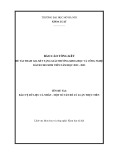
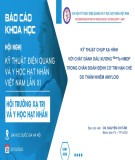

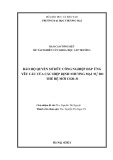
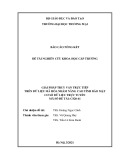
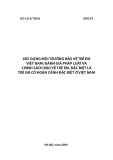

![Vaccine và ứng dụng: Bài tiểu luận [chuẩn SEO]](https://cdn.tailieu.vn/images/document/thumbnail/2016/20160519/3008140018/135x160/652005293.jpg)
